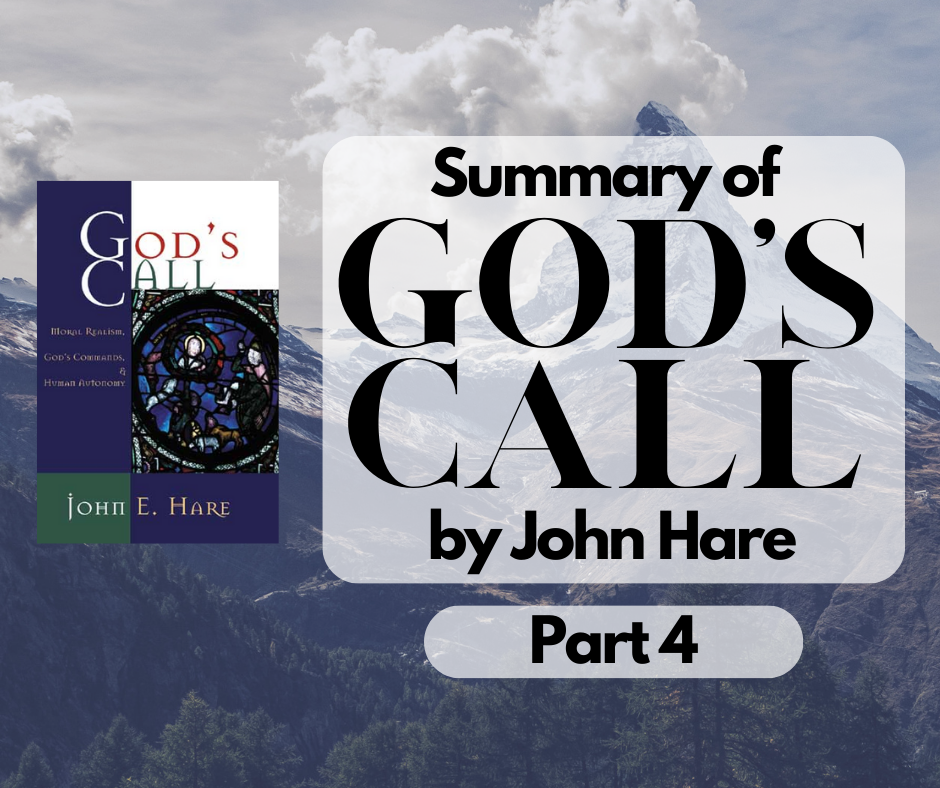John Hare’s The Moral Gap provides what we can call a “performative” version of the moral argument for God’s existence. Hare teaches at Yale and is the son of famed philosopher R. M. Hare, whose work John interacts with quite a bit in his own writings. In a series of extended blogs, I intend to go through Hare’s Moral Gap chapter by chapter to give folks who aren’t familiar with it an exposure to the sorts of arguments the book contains. This is not a critical review, just a quick and cursory summary of salient content. The book is about the “gap” between the moral demand on us and our natural capacities to live by it. It identifies what secularists attempt to do in the face of such a gap, and the way theism and Christianity offer powerful and better resources to close the gap. The book is much inspired by the writings of Immanuel Kant, an important influence on Hare.
The first chapter is entitled “Kant and the Moral Demand,” and it argues that Kant was vividly aware of the moral gap, both because he considered the moral demand to be very high and, as one influenced by the Lutheran pietistic tradition, recognized that we are born with a natural propensity not to follow it. Hare begins his analysis by laying out some key features of a Kantian ethical system, starting with the Categorical Imperative (CI). In this chapter Hare discusses the first two versions of the CI: the Formula of Universal Law, and the Formula of the End in Itself. The Formula of Universal Law says act only on maxims you can will as universal law. A maxim is the subjective principle of an action. To say the principle is subjective is to say that it’s the prescription made by the subject from which the action follows.
Kant talks as though each action has exactly one maxim from which it follows. This raises a problem concerning the level of generality of various maxims. A potential problem for Kant’s analysis is that for each action there may be ever so many maxims of varying levels of generality, some of which may be universalizable, some of which may not be. Hare bypasses this concern altogether by pointing out that Kant thought that there are, in the end, only two maxims: the good maxim and the bad maxim. All actions come from one or the other. The Good Maxim subordinates all desires to duty, whereas the Bad Maxim subordinates duty to the desires. For Kant duty trumps; in fact only those actions motivated by respect for the moral law, on his view, contains moral worth. So take suicide, a potential action whose maxim might look something like this: “From self-love I make it my principle to shorten my life if its continuance threatens more evil than it promises pleasure.” Such a maxim is bad, and thus suicide, on Kant’s view, is always wrong. Why such a maxim fails the test of universality is something we’ll consider in more detail in a moment. Good maxims are specific enough to give guidance, general enough to be taught to children, and exceptionless.
The CI tests maxims; if a maxim meets the test, the action that follows from it has moral worth; if the maxim doesn’t meet it, the action lacks moral worth. What is the test? Hare thinks the clearest account of the Formula of Universal Law is that it requires willingness to continue subscription to the maxim of an action even if all individual or singular reference is excluded from it. This isn’t how Kant himself put it, but Hare thinks it captures the gist of what Kant was after. In considering the performance of an action, I identify the maxim underlying the action, excluding the specifics such as the fact that I’m the one considering the action for myself, and I ask a question like this: Is this maxim an appropriate prescription for anyone and everyone in relevantly similar circumstances? If not, the action should not be performed. We’ll consider a few ways in which a maxim can fail this test in a moment.
The second formulation of the CI is the Formula of End in Itself. This version of the CI declares you should act in such a way that you always treat humanity, whether in your own person or in the person of any other, never simply as a means, but always at the same time as an end. Other persons serve as a moral limit on our actions. Treating humanity as an end in itself is, for Kant, respecting our capacity for free and rational choice; it’s respecting autonomy. To treat another human being as merely a means is to ignore the other as a center of agency. Some, like Korsgaard, seem to push this Kantian idea in the direction of affirming the intrinsic value of persons; for Kant the focus was more specifically centered on agency, which entails that coercion and deception, for obvious reasons, represent rather paradigmatic violations of the principle. Kant even goes further to suggest that, so far as possible, we are required to share the ends of others, which is reflective of, among other things, a deeply communal aspect of his ethical theory.
Adherence to the CI avoids two sorts of self-contradiction, namely, contradiction in the conception, and contradiction in the will. An example of the former might be this: Consider a scenario in which you need a loan, but to get the loan you have to promise to repay it in a timely fashion. Unfortunately, you know you won’t be able to do so. But you want the loan nonetheless and are tempted to lie about repaying it in order to secure it. Lying would be wrong in such a case, Kant says, because it would be based on a maxim that can’t be universalized because it implicated you in a contradiction in the conception. By lying you’re acting on a maxim that, if everyone in relevantly similar circumstances were to follow, would potentially destroy the very institution of money-lending on which you’re depending to get the loan. So you want the institution to be there, but by following a maxim that if universally followed would destroy the institution, you don’t want it to be there. This is a self-contradiction.
The other form of contradiction is a contradiction of the will, which results from, for example, systematically denying assistance to others. There’s logical space for doing this that there isn’t in the loan example, but there is still a contradiction of sorts at play. For, again, Kant saw that we are deeply communal beings who rely and depend on each other all the time. Invariably there will be times when you need the assistance of others; but if everyone were to refrain from helping others, the help you’ll eventually need won’t be forthcoming. If you want the help to be available, yet affirm a maxim that would prevent it, as in this case, you’re implicated in a contradiction of the will. When a maxim falls prey to either form of contradiction, it’s unable to be consistently willed as a universal law. It implicates one in a contradiction and is thus irrational and immoral.
At this point in the chapter Hare spends time discussing the views of his father, who was much influenced by Kant. R. M. Hare thought that moral judgments, to qualify as such, need to be universalizable, prescriptive, and overriding. He also distinguished between intuitive and critical levels of moral thinking. Our intuitions are liable to mislead us on occasion, as critical reflection shows, but even our critical reflection can mislead us because it optimally requires complete information and complete impartiality—the perspective of the “archangel.” The position of the archangel is also taken to be the position of God—though the elder Hare had lost his faith along the way. Still, it’s only judgments at the critical level of the archangel (or God) that are overriding; thus there’s a gap between the divine and human capacities, for we are afflicted with all manner of deficiencies in our moral reflections, from lack of knowledge or impartiality to lack of sensitivity and sympathy. God, either real or hypothetical, would presumably not be similarly disadvantaged.
In Kant too we find poignant recognition of such a gap, for as we engage in moral deliberation we continually encounter the “dear self,” an inflated sense of our own interests and concerns, resulting in an unbridgeable chasm between ‘ought’ and ‘can’. The result is that morality, in its full critical form, is, first, something I ought to be practicing; second, something for which my natural capacities are inadequate (except by approximation); and third, something that I should treat as the command of some other at least possible being who is practicing it. On this picture, morality has three parts: 1. The moral demand; 2. Our defective natural capacities (lack of sensitivity, sympathy, etc.); and 3. The possible being (the authoritative source of the demand). Hare suggests this structure is a holdover from Christianity: Belief in a perfect and infinite moral being, whom we imperfectly resemble, and who created us to resemble him more than we do.
One result of such a structure is that it produces a constant and inevitable sense of failure of a variety of sorts. We fail by caring more for ourselves than others, we show failures of patience, failures of impartiality, etc. This makes the desire to avoid guilt a primary moral motivator, though love the moral law is the nobler moral motivation than the desire to avoid subjective feelings of guilt. We desire to close the gap between what we do and what we ought to do. Yet we seem to be under a demand too great for us to meet without God’s grace to transform us.
Hare identifies three strategies for addressing the gap from a secular perspective: 1. Produce a naturalistic substitute for God’s assistance; 2. Exaggerate our sense of what we can accomplish, so as to fit the demand; and 3. Reduce the demand so as to fit our capacities. A Christian solution will instead be God’s assistance to enable us to do what we can’t do on our own. Augustine says, “God bids us do what we cannot, that we may know what we ought to seek from him.” So the principle of deontic logic that ‘ought implies can’ may need tweaking; we may well be responsible for meeting a demand we can’t meet on our own resources, if there are additional resources outside of ourselves we can and should use that enable us to meet the demand.
Hare ends the chapter by suggesting that believers should value Kant, rather than seeing his work as opposed to their own convictions. Hare will offer criticisms of Kant, but nonetheless thinks there are resonances with Christian thought. For example, Christians should recognize Kant’s three-fold nature of morality: an original predisposition to do good, an innate propensity to evil, which can be overcome by a revolution of the will which requires divine supplement. Hare suggests that what we have here is quite analogous of the tripartite structure of Creation, Fall, and Redemption. Like Kant, too, believers should recognize the need for moral faith, which has two parts: faith in the actuality of virtue and in the consistency of happiness and virtue, both of which require belief in God’s work on our behalf.
Photo: "Mind the Gap" by Lisa. CC License.




















